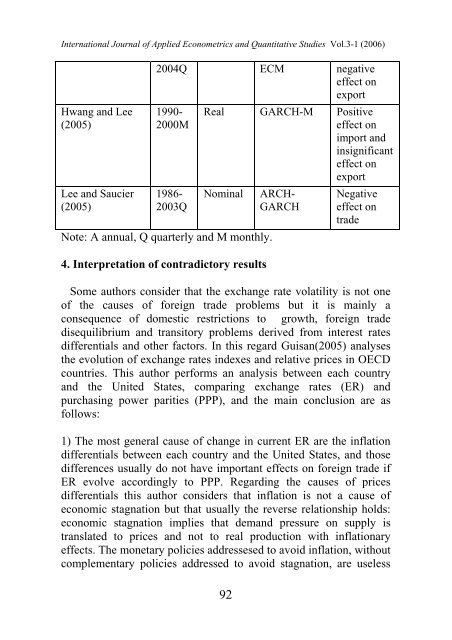EXCHANGE RATE VOLATILITY AND TRADE: A LITERATURE ...
EXCHANGE RATE VOLATILITY AND TRADE: A LITERATURE ...
EXCHANGE RATE VOLATILITY AND TRADE: A LITERATURE ...
You also want an ePaper? Increase the reach of your titles
YUMPU automatically turns print PDFs into web optimized ePapers that Google loves.
International Journal of Applied Econometrics and Quantitative Studies Vol.3-1 (2006)<br />
Hwang and Lee<br />
(2005)<br />
Lee and Saucier<br />
(2005)<br />
2004Q ECM negative<br />
effect on<br />
export<br />
1990-<br />
2000M<br />
1986-<br />
2003Q<br />
Real GARCH-M Positive<br />
effect on<br />
import and<br />
insignificant<br />
effect on<br />
export<br />
Nominal<br />
Note: A annual, Q quarterly and M monthly.<br />
4. Interpretation of contradictory results<br />
ARCH-<br />
GARCH<br />
Negative<br />
effect on<br />
trade<br />
Some authors consider that the exchange rate volatility is not one<br />
of the causes of foreign trade problems but it is mainly a<br />
consequence of domestic restrictions to growth, foreign trade<br />
disequilibrium and transitory problems derived from interest rates<br />
differentials and other factors. In this regard Guisan(2005) analyses<br />
the evolution of exchange rates indexes and relative prices in OECD<br />
countries. This author performs an analysis between each country<br />
and the United States, comparing exchange rates (ER) and<br />
purchasing power parities (PPP), and the main conclusion are as<br />
follows:<br />
1) The most general cause of change in current ER are the inflation<br />
differentials between each country and the United States, and those<br />
differences usually do not have important effects on foreign trade if<br />
ER evolve accordingly to PPP. Regarding the causes of prices<br />
differentials this author considers that inflation is not a cause of<br />
economic stagnation but that usually the reverse relationship holds:<br />
economic stagnation implies that demand pressure on supply is<br />
translated to prices and not to real production with inflationary<br />
effects. The monetary policies addressesed to avoid inflation, without<br />
complementary policies addressed to avoid stagnation, are useless<br />
92

















